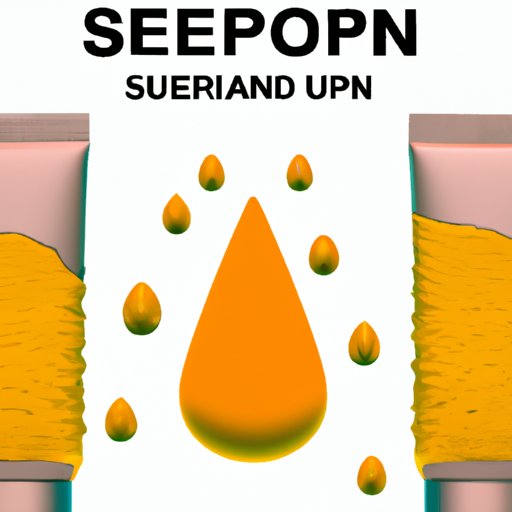
Introduction
Many people believe that sunscreen prevents tanning or that wearing it means sacrificing a sun-kissed glow. However, this is a common misconception that needs to be cleared up. This article aims to explore the relationship between sunscreen and tanning, debunking the myths and truths surrounding this topic.
The Truth About Sunscreen: How Much Protection Does it Really Offer?
Before diving into the debate around sunscreen and tanning, it is important to understand how sunscreen works. Sunscreen’s main function is to shield the skin from the sun’s harmful rays. It works by absorbing or reflecting UV radiation to prevent it from damaging the skin.
Sun Protection Factor (SPF) measures a sunscreen’s ability to protect against UVB rays, which are primarily responsible for causing sunburn. The higher the SPF, the more protection the sunscreen offers. For example, SPF 30 blocks about 97% of UVB rays, while SPF 50 blocks about 98% of them.
While higher SPFs offer more protection than lower ones, it is important to note that they are not foolproof. It is still possible to get a sunburn or tan while wearing sunscreen, especially if it is not applied correctly or reapplied often enough.
Tanning V.S. Sun Protection: The Debate Continues
The debate around whether tanning is healthy or not is ongoing. Some people argue that a tan gives the skin a healthier appearance, while others argue that any type of tanning is harmful to the skin.
What is clear is that sun damage can have negative effects on the skin. Exposure to UV radiation can cause premature aging, skin discoloration, and even skin cancer. Therefore, it is important to protect your skin from the sun whenever possible.
The Pros and Cons of Sunscreen: Can You Still Achieve a Tan?
While sunscreen is widely recognized as an effective means of protecting the skin, some people avoid it because they believe it will prevent them from tanning. However, this is not entirely true.
Sunscreen does not completely block UV radiation, and therefore, you can still achieve a tan while wearing it. However, the degree of tanning may be less than it would be without sunscreen. Additionally, some sunscreens may contain ingredients that block the tanning process, such as zinc oxide or titanium dioxide.
There are pros and cons to using sunscreen for tanning. On the one hand, sunscreen can protect the skin from harmful UV radiation and prevent sunburn. On the other hand, it may limit the degree of tanning achieved or take longer to develop a tan.
Sunscreen Myths Busted: Why You Can’t Rely on SPF for Tanning
There are many myths surrounding sunscreen and tanning. One of the most common is that a higher SPF means a longer-lasting tan. However, this is not true. SPF only measures the level of protection against UVB rays, which cause sunburn and not the time it takes for a tan to develop.
Another myth is that using sunscreen will prevent you from getting a tan altogether. As previously mentioned, sunscreen does not entirely block UV radiation. Additionally, the degree of tan achieved may vary depending on the type of sunscreen used and how frequently it is applied.
It is important to remember that achieving a healthy tan is possible, but it should not be pursued at the cost of skin health.
What Experts Say about Tanning While Wearing Sunscreen
Dermatologists and other skin experts generally recommend that individuals wear sunscreen to protect their skin from the sun’s harmful rays. However, they also acknowledge that it is possible to achieve a tan while wearing sunscreen.
Dr. Francesca Fusco, a New York-based dermatologist, recommends that individuals use a self-tanning lotion as an alternative to sunbathing. “You can get a gorgeous golden glow without exposing yourself to UV rays,” she states.
It is important to find a balance between sun protection and tanning goals. Staying in the shade during peak sun hours, wearing protective clothing, and reapplying sunscreen regularly can help you achieve both goals.
The Dangers of Tanning Without Sunscreen: Why It’s Not Worth the Risk
Tanning without protection can have severe consequences for the skin. Overexposure to UV radiation can lead to sunburn, premature aging, and skin cancer. According to the Skin Cancer Foundation, individuals who first use a tanning bed before age 35 have a 59% higher risk of developing melanoma, the deadliest form of skin cancer.
These stats emphasize the importance of protecting your skin from the sun’s harmful rays. While a tan may be desirable, it is not worth the risk.
How to Safely Get a Tan While Wearing Sunscreen: Tips and Tricks
While wearing sunscreen can limit the degree of tanning achieved, there are ways to achieve a healthy tan while still protecting your skin.
One way to do this is to use a self-tanning lotion or spray. These products can create a realistic, sun-kissed look without exposing the skin to harmful UV radiation.
If you prefer to sunbathe, experts recommend spending short periods of time in the sun, preferably during non-peak hours. Reapplying sunscreen regularly and wearing protective clothing, such as a hat or a cover-up, can also help limit sun damage.
Conclusion
Overall, the relationship between sunscreen and tanning is a complex one. While wearing sunscreen can limit the degree of tanning achieved, it is still possible to achieve a healthy glow without sacrificing skin health. By finding a balance between sun protection and tanning goals, individuals can enjoy the benefits of the sun while protecting themselves from its harmful effects.
Remember, a healthy tan is achievable, but it should never come at the cost of skin health.




